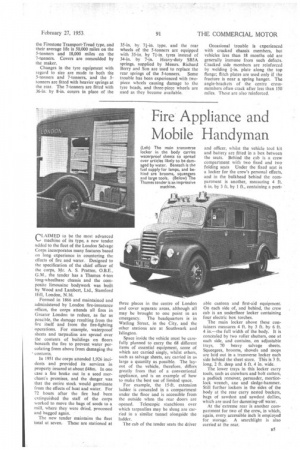Fire Appliance and Mobile Handyman
Page 39

If you've noticed an error in this article please click here to report it so we can fix it.
CLAIMED to be the most advanced %.■ machine of its type, a new tender added to the fleet of the London Salvage Corps incorporates many features based on long experience in countering the effects of fire and water. Designed to the specification of the chief officer of the corps, Mr. A. S. Pratten, 0.B.E., G.M., the tender has a Thames 4-ton long-wheelbase chassis and the composite limousine bodywork was built by Wood and Lambert, Ltd., Stamford Hill, London, N.16.
Formed in 1866 and maintained and administered by London fire-insurance offices, the corps attends all fires in Greater London to reduce, as far as poss:ble, the damage resulting from the lire itself and from the fire-fighting operations. For example, waterproof sheets and tarpaulins are spread over the contents of buildings on floors beneath the fire to prevent water percolating from above from damaging the • contents.
In 1951 the corps attended 1,926 incidents and provided its services in property insured at about £48m. In one case a fire broke out in a seed merchant's premises, and the danger was that the entire stock would germinate from the effects of heat and water. For 72 hours after the fire had been extinguished the staff of the corps lsorked to move the bags of seeds to a mill, where they were dried, processed and bagged again.
The new tender maintains the fleet total at seven. These are stationed at three places in the centre of London and cover separate areas, although all may be brought to one point in an emergency. The headquarters is in Watling Street, in the City, and the other stations are at Southwark and Islington.
Space inside the vehicle must be carefully planned to carry the 68 different items of essential equipment, some of which are carried singly, whilst others, such as salvage sheets, arc carried in as large a quantity as possible. The layout of the vehicle, therefore, differs greatly from that of a conventional appliance, and is an example of how to make the best use of limited space.
For example, the 15-ft. extension ladder is concealed in a compartment under the floor and is accessible from the outside when the rear doors are opened. Telescopic stanchions over which tarpaulins may be slung are carried in a similar tunnel alongside the ladder.
The cab of the tender seats the driver able canteen and first-aid equipment. On each side of, and behind, the crew cab is an underfloor locker containing four electric box torches.
The main locker above these containers measures 4 ft. by 3 ft. by 6 ft. 4 in.—the full width of the body. It is concealed by two roller shutters, one at each side, and contains, on adjustable trays, 70 heavy salvage sheets. Squeegees, brooms, shovels and mops are laid out in a transverse locker each side behind the sheet store. This is 3 ft. long, 2 ft. deep and 6 ft. 4 in, wide.
Tlse lower trays in this locker carry tools, such as crowbars and bolt cutters, a padlock remover, persuader, morticelock wrench, axe and sledge-hammer. Still further lockers in the sides of the body at the rear carry nested buckets, bags of sawdust and sawdust dollies, which are used for damming-off water.
At the extreme rear is another compartment for two of the crew, in which, again, every accessible inch is emp:oyed for storage. A searchlight is also carried at the rear.




















































































